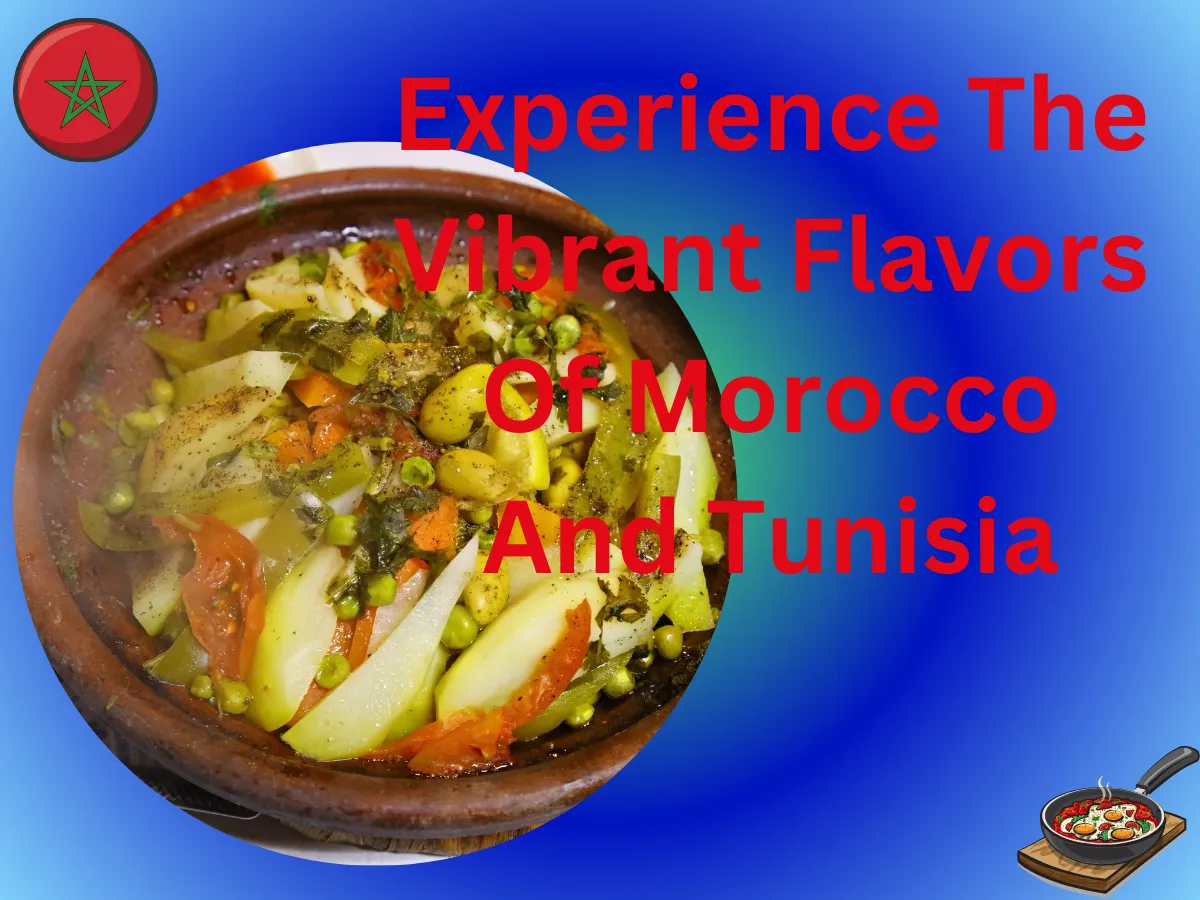Last updated on September 1st, 2025 at 03:18 am
Tunisian and Moroccan Cuisine is a tapestry of flavors and textures deeply rooted in their cultural heritage and history. Both cuisines blend various influences, including Berber, Arab, Andalusian, and Mediterranean. Despite sharing some similarities, each has distinct characteristics that set them apart.
Significance of Food in Moroccan and Tunisian Culture
In both Moroccan and Tunisian cultures, food is much more than sustenance—it’s a celebration of life, heritage, and community. Meals are a time for families to gather, share stories, and enjoy each other’s company. The act of preparing and sharing food is imbued with love and respect, often considered an expression of hospitality and generosity.
- Social Gatherings: In Morocco and Tunisia, significant events such as weddings, births, and religious holidays are marked by the preparation and sharing of specific foods. For instance, during Ramadan, the fast is broken with dates and milk, followed by a rich spread of delicacies.
- Hospitality: Offering food is a sign of welcome and generosity in both cultures. It’s common for hosts to prepare more food than can be eaten to show abundance and ensure that guests are well-fed.
- Festivals and Celebrations: Specific dishes are associated with particular festivals. For instance, in Morocco, couscous is traditionally served on Fridays, the Islamic holy day, while in Tunisia, Assidat Zgougou is prepared
Popular Dishes in Moroccan and Tunisian Cuisine
Moroccan Cuisine:
Moroccan cuisine is a mosaic of flavors, combining sweet, savory, and spicy elements in dishes that are as visually appealing as they are delicious.
- Tagine: A slow-cooked stew that can include meat (usually lamb or chicken), vegetables, and sometimes fruits. The dish is named after the conical clay pot it’s cooked in, which helps circulate moisture and flavor.
- Couscous: Steamed balls of semolina, usually served with stewed meat and vegetables. It’s a staple in Moroccan cuisine and is often considered the national dish.
- Pastilla: A unique pie combining sweet and savory flavors, traditionally made with pigeon meat (though chicken is now more common), almonds, and spices, wrapped in thin, crispy warqa pastry.
- Harira: A rich soup typically made with tomatoes, lentils, chickpeas, and lamb, seasoned with a blend of herbs and spices. It’s particularly popular during Ramadan.
Tunisian Cuisine:
Tunisian cuisine is distinguished by its fiery spices and the prominence of seafood. It’s a testament to the country’s historical crossroads of Mediterranean civilizations.
- Couscous: While also a staple in Moroccan cuisine, Tunisian couscous tends to be spicier and is often served with fish or seafood.
- Brik: A thin pastry wrapped around a filling of egg, tuna, capers, and herbs, then deep-fried. It’s a popular starter or a light meal.
- Chorba: A spicy and fragrant soup made with lamb, vegetables, and herbs, often served with bread or over couscous.
- Tunisian Tagine: Unlike the Moroccan version, Tunisian tagine is more like an Italian frittata or quiche, made with a mix of bread, meat, cheese, and vegetables.
Traditional Moroccan Cuisine and Tunisian Desserts and Sweets
Moroccan Desserts and Sweets:
Moroccan desserts are a delightful fusion of flavors, where sweetness is often balanced with the subtle use of spices like cinnamon and anise. Key ingredients include almonds, sesame seeds, honey, and fruits, particularly dates and figs.
- Chebakia: A sesame cookie that is fried and then dipped in honey, often sprinkled with sesame seeds. It’s particularly popular during Ramadan.
- Baklava: Layers of phyllo dough, filled with chopped nuts and soaked in honey or syrup.
- Seffa: A dessert made from couscous or thin noodles, mixed with raisins, powdered sugar, cinnamon, and sometimes butter. It’s a unique dish that perfectly marries sweet and savory flavors.
- Moroccan Mint Tea and Pastries: Serving sweet mint tea with pastries like cornes de gazelle (crescent-shaped cookies filled with almond paste) is a sign of hospitality.
Tunisian Desserts and Sweets:
Tunisian sweets are not just treats but a celebration of their rich cultural heritage. They are often marked by the use of dates, nuts, and honey.
- Makroudh: A semolina pastry filled with dates or nuts, fried and then dipped in syrup. It’s especially popular during religious festivals.
- Baklava: Similar to its Moroccan counterpart but may include a variety of nuts and is often infused with a syrup made from orange blossom water.
- Yoyos (Tunisian Doughnuts): Deep-fried dough balls that are soaked in syrup and sometimes sprinkled with sesame seeds.
- Assidat Zgougou: A unique Tunisian dessert made during the festival of Mouled, consisting of a jelly-like pudding made from pine nuts, adorned with cream, and topped with nuts.
Traditional Moroccan Cuisine and Street Food
Best Moroccan Street Food Dishes
The streets of Morocco buzz with the vibrant energy of markets (souks) and the enticing aromas of street food. The heart of Moroccan street food culture lies in its bustling medinas, where vendors offer an array of traditional delicacies.
- Must-Try Street Foods:
- Tajine: Even on the street, you can find mini Tajines simmering with meat and vegetables.
- Brochettes (Kebabs): Skewers of spiced meat grilled over open flames.
- Maakouda: Potato patties, often stuffed in bread with salad and sauce.
- Market Experience:
- The souks are not just places to shop but to immerse oneself in Moroccan culture, haggling over spices, textiles, and artisanal goods.
- The Djemaa el-Fna in Marrakech is particularly famous, coming alive in the evening with food stalls, storytellers, musicians, and performers.
Popular Tunisian Street Food
Tunisian street food offers a blend of Mediterranean freshness and the rich spices typical of North African cuisine. The markets are lively, colorful, and full of the scents of fresh produce and sizzling dishes.
- Must-Try Street Foods:
- Brik: A thin pastry filled with egg, tuna, or minced meat, then deep-fried to perfection.
- Fricassé: Small fried buns stuffed with tuna, harissa, olives, and capers.
- Couscous: Served in many street stalls, often with fish or lamb and a spicy broth.
- Market Experience:
- Tunisian markets (souks) are vibrant hubs of activity, offering everything from fresh produce to hand-crafted pottery and jewelry.
- The Central Market in Tunis is renowned for its wide array of fresh ingredients, while traditional souks in smaller towns provide a more intimate glimpse into Tunisian life and traditions.
In both countries, the street food and market culture offer an authentic taste of local life, where food is not just nourishment but a celebration of community, tradition, and the rich tapestry of flavors that define Moroccan and Tunisian heritage.






February 7, 2024 at 9:35 am[…] Pistacho Stuffed Dates […]
February 10, 2024 at 5:20 pm[…] […]
February 13, 2024 at 5:51 pm[…] […]
February 18, 2024 at 6:16 am[…] […]
February 20, 2024 at 3:27 pm[…] […]